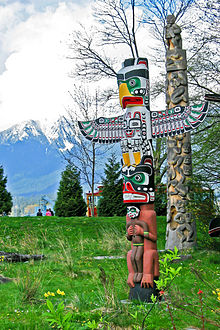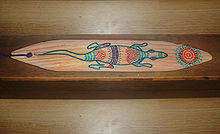Totemism
Totemism is an ethnological (sometimes also religious-scientific) umbrella term for various social concepts or beliefs in which people have a mythical, kinship-like connection to certain natural phenomena (animals, plants, mountains, springs, etc.) - the so-called totems - which, as symbols, have an important meaning for finding one's identity.
The term "totem" stands for the symbol either in the sense of a profane metaphorical name or group badge - or a sacred symbol. Accordingly, one distinguishes in totemism both social and religious aspects. The meaning of totems varies greatly from culture to culture: for many Aborigines they are (or were) power-bearing spiritual badges that connect people with the environment and the Dreamtime and are associated with sacred places, times, symbols or actions. In many ethnic groups of other continents totems are explained magically-mythologically, but in everyday life they are often "only" profane names for the classification and recognition of social groups in accordance with the natural order and for the preservation of cosmic-relational relations. At the same time, psychologically speaking, a totem in any form is clearly more "effective and profound" than any modern sign of recognition. The assignment and/or connection "religious or social" is, however, a frequent subject of dispute among ethnologists, since a sharp separation is usually not possible.
Almost all totemic ideas have two basic prohibitions associated with them:
- The "related" natural objects may neither be killed nor damaged or eaten (in times of great need, however, totem animals may only be killed by persons belonging to that totem in some ethnic groups).
- Sexual relations within a totem clan are strictly taboo.
Every totemic conception extends the concept of kinship to natural contexts in order to integrate the alien and threatening into the human world.
This "kinship" is not seen in a biological but in a purely mythological sense; however, it is interpreted very differently depending on the ethnic group: Some Australian Aborigines and the South African Khoisan, for example, see in the totem a direct common descent, while among Central African tribes only a distant kinship relationship is assumed.
Totemic ideas have been described worldwide, especially among those indigenous peoples who divide themselves into different lineages or clans.
Due to the scientific ambiguity of religiously motivated ideas, which mostly concern the individual, many modern ethnologists now only consider totemism in its collective manifestation, in which the totem stands as a symbol for the togetherness of social groups (group totemism). Here, the totem represents certain desirable - often anthropomorphized - characteristics or behaviors of animals, plants, or other natural objects, which are thus adopted into the cultural behavioral repertoire. It is often difficult to discern whether a totem was chosen to fit the pre-existing characteristics of the group; or whether these characteristics only developed over time through the selection of the totem and the belief in mythical kinship.
Totemic ideas still occur today, especially in central and southern Africa among some traditional societies, among some Australian and Melanesian tribes, and among non-Christianized nature-loving indigenous peoples of Central and South America.

Typical of the Northwest Coast culture of North America are the totem poles: sculptural representations of clan totems with political, social, and mythological meanings
Etymology and original idea
The incorrect interpretation of the terms ototeman (Ojibwe language: blood-related siblings) and nintotem (family insignia after animal names) of the five clans of the Anishinabe Indians of southeastern Canada, in conjunction with the idea of personal guardian spirits, led in early ethnology to the idea that a totem was always a spiritual spirit being in the form of an animal, a plant or a mineral. This distorted idea was soon applied to similar phenomena among other peoples in a rather arbitrary and culturally comparative manner. In the ethnology of the late 19th and early 20th centuries, this gave rise to the idea of a globally widespread totemism as a "universal primordial religion" (→ also: animistic theory of religion). In this sense, the concept of totemism is now considered outdated.

Pictograms of the Anishinabe, from whom the term "totem" originates
Types of totemism
Totemic ideas vary considerably from culture to culture and are not, in the modern view, a universal religious or social phenomenon of early human development. This is clearly expressed in the manifold problems of clearly defining, delimiting, and subdividing totemism: It is primarily an artificial, scientific construct.
A distinction is commonly made between individual, gender and group totemism, depending on whether an individual, a gender group or an entire clan is related to the totem. The latter form is by far the most common.
Even this distinction is not always easy. In North America, Australia and Africa, for example, one finds examples of ethnic groups with collective and individual totemism.
As already described, it is also difficult to distinguish between religious or social significance: in Polynesia or among the Yanomami there is almost no social aspect, in Africa social and religious functions are discernible, and in North America the emphasis is almost everywhere on social significance.
Some authors emphasize that the spiritual protection spirit concept should not be considered in isolation from clan totemism: the one as well as the other is rooted in mythology and any conceptual separation is thus artificial.
Individual Totemism
Personal totemism is largely religiously motivated, even if this is undisputed only among a few ethnic groups: it usually involves the idea of a personal guardian spirit in the form of an animal. A classic example from Australia are the Arrernte: According to their belief, one receives one's totem from the Tjuringas of the sacred place where the mother passed by shortly before she became pregnant. A tjuringa in this case is a stone object of an ancestor in which his soul has manifested. For many North American Prairie Indians, the personal animal spirit appeared during the vision quest (rite of passage).
By contrast, many authors do not treat "alter ego double souls" in the form of a concrete animal (more rarely a plant) - as among the Yanomami or the peoples of Mesoamerica (→ Nagual) - as totemic phenomena, but place them in shamanistic or animistic contexts. Alter ego conceptions are only included among the totemic concepts if at the same time a direct descent from a common ancestor is assumed and corresponding taboos exist for sexual contacts with people of the same totem. Among the African Kpelle, for example, the alter ego punishes its owner as soon as the latter transgresses one of the totemic prohibitions.
Totemic clans
Profanely motivated group totems serve to classify and recognize social groups in accordance with the natural order and to strengthen cosmic kinship relations. This is the case, for example, with the Maya ethnic groups in the highlands of Chiapas, where to this day each descent group bears the name of an animal, a plant or a natural object. Clan members are not allowed to marry each other and live separately from other clans. The clan name symbolizes the common ancestor, of whom there is usually no concrete memory.
Totemic clans are:
- People who are biologically closer or more distantly related to each other, or those who consider themselves related by blood,
- that use a natural object as a common symbol of identity that metaphorically represents the individual characteristics of the group,
- whose clantotem stands as an emotional symbol for often rigorous behavioural rules and regulations
- whose totem and common descent is mythologically linked to prehistory and ancestors
- and who often do not live separately, but among members of other clans.
A person always has a clantotem from birth. Depending on whether the relationship is patrilineal or matrilineal, the totem is inherited from the paternal or maternal line. In Central Africa, however, it also happens in matrilineal clans that the totem is inherited from the matrilineal clan, but that the more important totem comes from the patrilineal clan.
As a rule, no group member is permitted to enter into sexual relations with a member of the same totem, regardless of whether the two are actually related. This mating rule, known as exogamy, results from the fact that originally - before the connection between mating and pregnancy was discovered - totem affiliation was only 'inherited' from the mother to her children, so that, with such matrilineal clan affiliation, sexual relations between the 'father' and the mother's daughters are explicitly not subject to any taboo. The incest taboo in the contemporary understanding of the term thus presupposes the recognition of paternity and the introduction of patrilineal succession only made possible by this.
Collective religious veneration of a particular totem animal, going beyond mere badging, is described for ancient Egypt, New Zealand, and Africa.

Passport of the Iroquois with the nine totemic clan symbols of the tribe

Artificial mounds in the shape of bears (Effigy Mounds National Monument, Iowa). A totemic connection is obvious.

Tjuringa whirling wood of the Aborigines with painted totem
Questions and Answers
Q: What is totemism?
A: Totemism is a belief about the relationship between people and nature.
Q: Where does the term "totem" come from?
A: The term totem comes from an Ojibwe word meaning "a relative of mine".
Q: Who was the first person to write about totemism?
A: The first person to write about totemism was a trader named James Long in 1791.
Q: In which regions of the world has totemism been recorded?
A: Totemism has been recorded across native tribes of America, Africa, and Australia.
Q: What are the usual totems for a kinship group?
A: The usual totems for a kinship group are animals or plants.
Q: How are totems represented in totemism?
A: Totems are represented in sacred objects in totemism.
Q: Who do totems belong exclusively to in totemism?
A: Totems belong exclusively to the kinship group in totemism.
Search within the encyclopedia